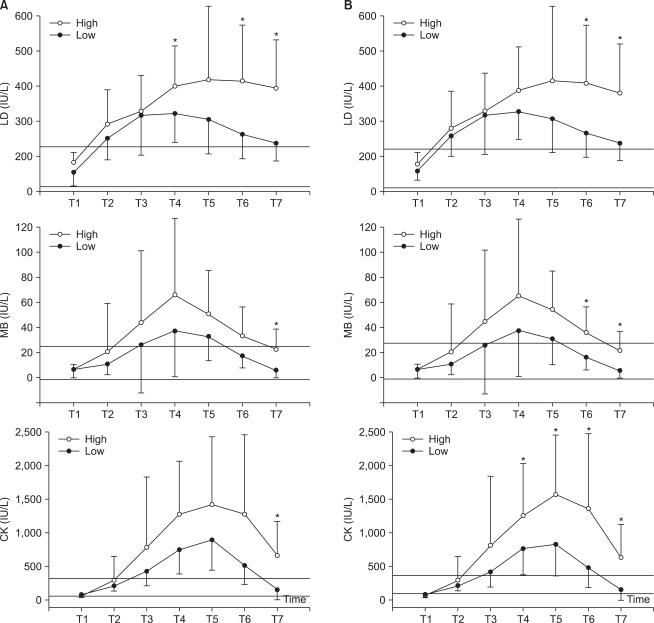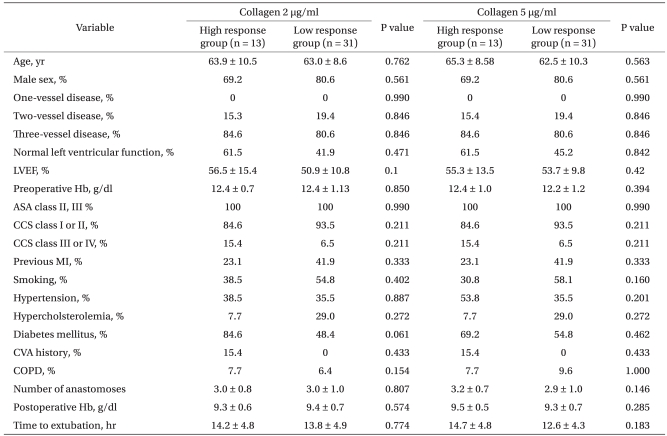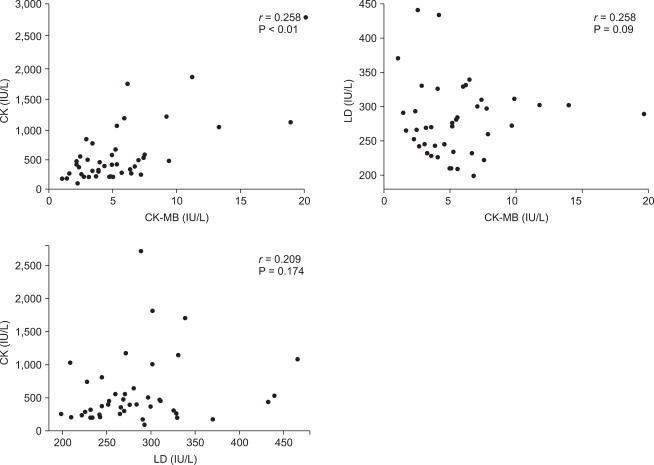1. Kahn ML. Platelet-collagen responses: molecular basis and therapeutic promise. Semin Thromb Hemost. 2004; 30:419–425. PMID:
15354263.

2. Svendsen E, Dalen H, Moland J, Engedal H. A quantitative study of endothelial cell injury in aortocoronary vein grafts. J Cardiovasc Surg (Torino). 1986; 27:65–71.
3. Mangano DT. Multicenter Study of Perioperative Ischemia Research Group. Aspirin and mortality from coronary bypass surgery. N Engl J Med. 2002; 347:1309–1317. PMID:
12397188.
4. Patrono C, Coller B, Dalen JE, FitzGerald GA, Fuster V, Gent M, et al. Platelet-active drugs: the relationships among dose, effectiveness, and side effects. Chest. 2001; 119:s39–s63.

5. Homoncik M, Jilma B, Hergovich N, Stochlawetz P, Panzer S, Speiser W. Monitoring of aspirin (ASA) pharmacodynamics with the platelet function analyzer PFA-100. Thromb Haemost. 2000; 83:316–321. PMID:
10739392.

6. Stein B, Fuster V, Israel DH, Cohen M, Badimon L, Badimon JJ, et al. Platelet inhibitor agents in cardiovascular disease: an update. J Am Coll Cardiol. 1989; 14:813–836. PMID:
2677086.

7. Ray MJ, Hawson GA, Just SJ, McLachlan G, O'Brien M. Relationship of platelet aggregation to bleeding after cardiopulmonary bypass. Ann Thorac Surg. 1994; 57:981–986. PMID:
8166553.

8. Bolli R, Marban E. Molecular and cellular mechanisms of myocardial stunning. Physiol Rev. 1999; 79:609–634. PMID:
10221990.

9. Hayes PD, Box H, Tull S, Bell PR, Goodall A, Naylor AR. Patients' thromboembolic potential after carotid endarterctomy is related to the platelets' sensitivity to adenosine diphosphate. J Vasc Surg. 2003; 38:1226–1231. PMID:
14681619.
10. Ellis EF, Oelz O, Roberts LJ, Payne NA, Sweetman BJ, Nies AS, et al. Coronary arterial smooth muscle contraction by a substance released from platelets: evidence that it is thromboxane A2. Science. 1976; 193:1135–1137. PMID:
959827.
11. Needleman P, Minkes M, Raz A. Thromboxanes: seledctive biosynthesis and distant biological properties. Science. 1976; 193:163–165. PMID:
945611.
12. Roth GJ, Stanford N, Majerus PW. Acetylation of prostaglandin synthase by aspirin. Proc Natl Acad Sci U S A. 1975; 72:3073–3076. PMID:
810797.

13. Taylor ML, Misso NL, Stewart GA, Thompson PJ. The effects of varying doses of aspirin on human platelet activation induced by PAF, Collagen and arachidonic acid. Br J Clin Pharmacol. 1992; 33:25–31. PMID:
1540486.

14. McKee SA, Sane DC, Deliargyris EN. Aspirin resistance in cardiovascular disease: a review of prevalence, mechanisms, and clinical significance. Thromb Haemost. 2002; 88:711–715. PMID:
12428082.

15. Nieswandt B, Schulte V, Bergmeier W, Mokhtari-Nejad R, Rackebrandt K, Cazenave JP, et al. Long-term antithrombotic protection by in vivo depletion of platelet glycoprotein VI in mice. J Exp Med. 2001; 193:459–469. PMID:
11181698.

16. Chen H, Locke D, Liu Y, Liu C, Kahn ML. The platelet receptor GPVI mediates both adhesion and signaling responses to collagen in a receptor density-dependent fashion. J Biol Chem. 2002; 277:3011–3019. PMID:
11723134.

17. Massberg S, Gawaz M, Gruner S, Schulte V, Konrad I, Zohlnhofer D, et al. A crucial role of glycoprotein VI for platelet recruitment to the injured arterial wall in vivo. J Exp Med. 2003; 197:41–49. PMID:
12515812.






 PDF
PDF Citation
Citation Print
Print






 XML Download
XML Download